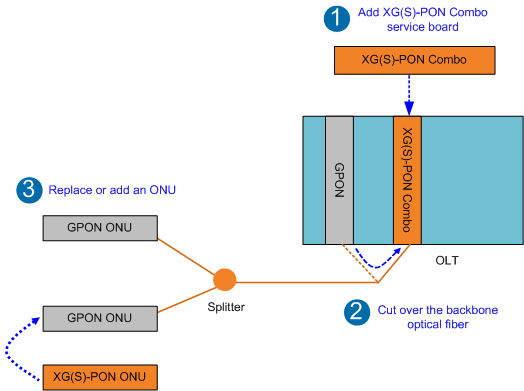With the emergence of new applications and services that require more bandwidth, there is a need for the passive network to be able to support these services and deliver the necessary bandwidth. GPON passive networks have become a bottleneck for these services. Given the facts, we will have the rise of the next generation of GPON technology, XG(S)-PON (10G GPON).

What’s XG (S) – PON?
XG (S) – PON is an enhanced next-generation PON technology that evolves from existing GPON technology standards. Some of the main features of this technology:
Higher bandwidth, capable of providing Internet access speeds of up to 10 Gbit/s. 4 times more than its predecessor GPON technology
Longest logical distance ≥ 60 km
Line Encryption on direction Downstream/Upstream
Split rate of up to 1:256
Differences between GPON, XG-PON and XGS-PON

Evolution from GPON to XG(S)- PON
The wavelength of XG(S)-PON and GPON do not overlap. Therefore, they can share the same ODN network through Wavelength Division Multiplexing (WDM).

If the OLT does not support XG(S)-PON, you will need to add a new OLT that does. This is a disadvantage, as it will have additional cost when purchasing a new OLT, and you will have to discard the GPON OLT when your network is fully XG(S)-PON. A second disadvantage is the cost of purchasing a WDM1r multiplexer, and the space it will take up on your DC. Huawei has a great migration solution using XG(S) – PON Combo
What’s XG (S) – PON Combo?
On the same PON port, we can have two passive technologies, being GPON + XGPON or GPON + XGS-PON. In addition, we have an optical module combo that integrates the GPON optical module, XG(S)-PON optical module, and WDM multiplexer to share ODN resources without adding an external WDM multiplexer.

Evolution Process
1. Add a board XG (S) – PON Combo
2. Migrate optical fiber from GPON port to XG port (S) – PON Combo
3. Add an ONU/ONT XG (S) – PON or change an existing ONU/ONT GPON

Huawei Equipaments that support XG (S)
OLT
SmartAX MA5800 Series (X2, X7, X15, X17)
EA5801
Board
H902CSHD - 8-port XGS-PON and GPON Combo OLT interface board.
H902CSHF - 16-port XGS-PON and GPON Combo OLT interface board. It works together with the optical network unit (ONU) to provide XGS-PON and GPON access services.
H902CGHD - 8-port XG-PON and GPON Combo OLT interface board. It works together with the optical network unit (ONU) to provide XG-PON and GPON access services.
H901CGHF -16-port XG-PON and GPON Combo OLT interface board. It works together with the optical network unit (ONU) to provide XG-PON and GPON access services.
ONT
HN8546Q, XG-PON ONT, 4GE+1POTS+2USB+2.4G&5G
HN8145V, XG-PON ONT, 4*GE+1*POTS+1*USB+2.4G/5G WIFI
HN8346V, XG-PON ONT, 4GE+1POT+2USB+2.4G/5G Wi-Fi
HN8546X6, XG-PON ONT, 4GE+2USB+1POT, 2.4G&5G Wi-Fi 6

